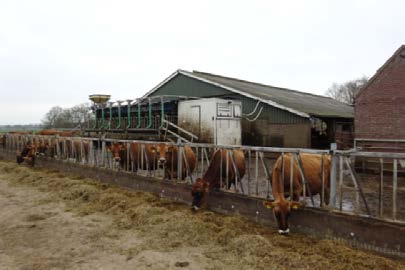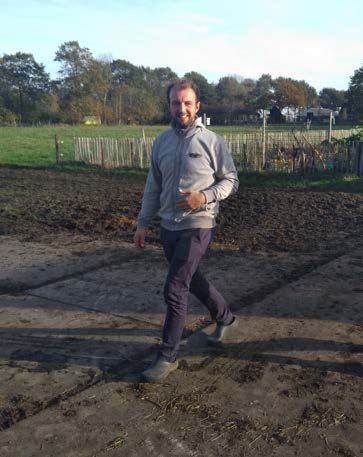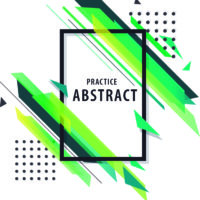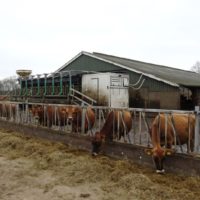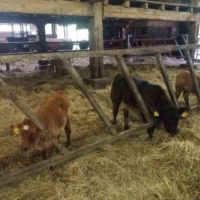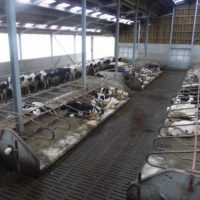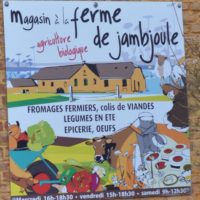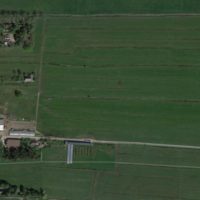Organic low-cost farm with own brand
Farm: “Farmer Bart”
Location: Rotstergaast, The Netherlands
Case study
 Organic low-cost farm with own brand (.pdf)
Organic low-cost farm with own brand (.pdf)
Description
Background
On the sandy soil in Rotstergaast in the province of Friesland (northern part of the Netherlands) is the farm of Bartele Holtrop settled. Farmer ‘Bart’ milks over 100 Jersey cows at his organic farm with about 50 hectares grassland in use. Four years ago he started realizing his dream; a farm based on a more natural production process that can last for a thousand years. This means for him that his farm can exist for a long time and not be dependent on others. Next generations must also have the opportunity to have a future on the farm. To achieve this goal, the farmer uses a low cost farming strategy based on maximum use of natural resources.
Farming management
The cows are grazed day and night from March to November. Maximum grazing is the base for the farm and therefore the herd is spring calving. The organic managed grassland is rich of a broad kind of different species of grass and legumes. The most common species and legumes are Italian ryegrass, perennial ryegrass, red and white clovers, goose grass and chicory.
Every 12 , the cows get a new piece of grass at their disposal. This change takes place after milking, because the cows are milked in the field. The farm uses a 2×15 mobile milking parlour. The mobile milking parlour can be moved anywhere by means of a tractor. A big advantage of this is that the soil is protected, because the cows do not have to go back to the shed. During milking, the cows get about 1 kg of grass-based concentrate next to the fresh grass. The organic milk is sold to a cheese factory. Last year, the farm has reached an important milestone. The Jersey milk was processed into an own cheese brand called ” the Tjonger”. The Jersey cows have a milk production of on average 4,200-4,500 liters milk per cow per year, with high levels of fat and protein.
The daily work on the farm is done by 2 AWUs (Annual Work Unit).
The machine park of the company is simple and for daily use only, based on the natural farming system. The machine park consists of:
The land processing, the spreading of manure and the harvesting is done by a contractor.
Financials
The annual costs of the farm activities are low due to the low cost management strategy. The cost price of the production of 1 liter milk is about €0.42. The annual main costs are the maintenance of the milking parlor and the purchase of organic concentrates and feed additives.
The selling price of the milk is on average about €0.65 per liter milk.
The net earnings of 1 liter milk are €0.23, so the farm is in a healthy financial situation.
The farm has a company-website with a lot of information about the activities on the farm: www.boerbart.nl.
The innovation
The grassland innovation of this farm is a low cost and maximum organic grazing system combined with an own brand for the cheese made of the milk. The own brand creates a high added value on a low cost production system.
The strategy of the farmer is based on creating added value for his own produced and branded organic products, based on an intensive grazing system, with focus on a sustainable farming system for the next generation.
The farmer has a farm system with a lot of grazing, with the focus on a low cost price. He tries to go back to the base with his farm and let nature do the work as much as possible. His goal is to produce milk from grass with as few unnatural interventions as possible. To realize this goal the farmer made the choice for the breed Jersey, a spring calving herd and a moveable milking parlor.
The moveable milking parlor has several benefits in his farming system;
- No need for (expensive) paved cow paths
- No loss of structure in grasslands due to walking cows from and to the plot
- Maximum grazing time
- All the plots can be grazed
The farmer is using a fixed rotational system for the grazing to maintain and enrich the organic grasslands. The movable milking parlor is always placed between the border of the just grazed grass and the fresh grass. When the cows leave the milking parlor, they walk directly into te new strip of fresh grass. The grassland management is completely done by the grazing of the cows. The grazing system keeps the grassland healthy and rich with several species of legumes according to the farmer.
Results
The main result of this innovative farm is a healthy financial organic farming system. The lower milk production in comparison with conventional farming is compensated by lower costs and added value. The farmers management creates a unique story for his own cheese brand.
The intensive grazing system used results in a low cost price and a relatively high production, a healthy soil (in balance) and a well-developed organic grassland rich of different grass and legumes species. There is a lot of biodiversity in the grassland. Also a result is the healthy and well-adapted herd to produce milk on this farming system. A final and important result is the inspiration to other farmers to experiment in their own farming system. The inspiring question is how to improve their farming system by using more natural processes.
Adoption criteria
Whether this innovative farming management can be easily adopted by other farms depends on the current situation of that farm and that farmer.
Important farm adoption criteria are:
- The breed of the herd; the typical Dutch Holstein-Friesian breed is not suited for an organic production method or a production method mainly based on grass.
- The availability of enough grassland for grazing.
- The current economic situation (recent investments of the farm housing and milking facilities).
Important farmer adoption criteria are:
- A moral passion and motivated for natural sustainable farming and own branding.
- Open minded – leaving well-known paths.
Future prospects
The system can be further improved by paying special attention to the balance between natural based and economic farming.
Additional information
| Farming system | organic farming |
|---|---|
| Domains of innovation | animal type (breed), farm system, forage mixture, grazing management system, marketing |
| Main types of animal | dairy cattle |
| Country | The Netherlands |
| Product type | Case study |
| Language | English |

